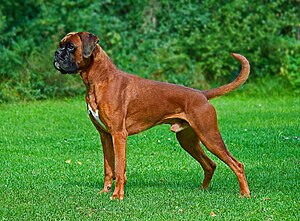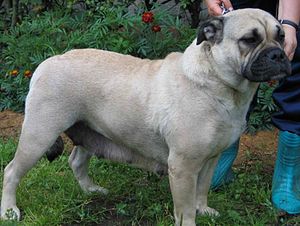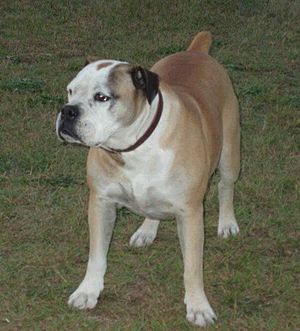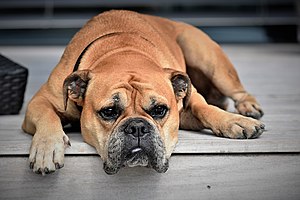Bulldog breeds

Bulldog breeds, also known as bull breeds, is a collective name for various dog breeds of a particular type. Historically, bulldog breeds originate from the molossian breeds and were used for bull-baiting, cattle catching, or dog fighting. They typically have a stocky square build, a large head and mouth, strong jaws, and a shortened muzzle. Several of the bulldog breeds are brachycephalic which brings several health risks.[1][2]
The smaller bulldog breeds are sometimes called "endearing and adorable" and have consistently ranked high in popularity.[2] In 2017, the American Kennel Club ranked the French Bulldog 4th most popular dog breed, and the Bulldog placed 5th.[3] The Kennel Club (UK) named the French Bulldog as the nation's favorite dog breed in 2018, outranking the Labrador Retriever for the first time since 1990,[4] and in 2016 the English bulldog made the top 10 list in several parts of the kingdom.[5]
Names and variants[edit]
Bulldog and its variations are used in the names of many breeds including: Alapaha Blue Blood Bulldog, American Bulldog, Bulldog, Bulldogge Brasileiro, Campeiro Bulldog, Catahoula bulldog, Continental bulldog, French Bulldog, Old English Bulldog (Extinct), Olde Boston Bulldogge, Olde English Bulldogge, Serrano Bulldog, Spanish Bulldog (Alano Español), and Toy Bulldog (Extinct).
Bull in a breed name, or variations of 'bull', are either a shortened variant of 'bulldog', or the breed has a bull-baiting background, or the dogs have bulldog style appearances. These include: American Bully, American Pit Bull Terrier, Bull and Terrier (Extinct), Bull Terrier, Bullenbeisser (Extinct), Bullmastiff, Bully Kutta, Miniature Bull Terrier, Pit bull, and Staffordshire Bull Terrier.
Lack of 'bull' in a name does not mean the dog is not a bulldog type. Some breeds are considered bulldog types but do not have 'bull' in the name, including: American Staffordshire Terrier, Boxer, and Ca de Bou.
Bully is a term with two meanings. In some circles it is an informal shortening for 'bulldog' and means any dog of bulldog type or nature. For others, bully breeds and bullies are terms used to indicate dogs only in the pit bull category, and include American Pit Bull Terrier, American Staffordshire Terrier, Staffordshire Bull Terrier, American Bulldog, American Bully, and less frequently Bull Terrier.
Bulldogge is usually used to indicate an old style bulldog, sometimes a recreated or resurrected breed. These include: Bulldogge Brasileiro, Olde Boston Bulldogge, and Olde English Bulldogge.
Bulldog breeds[edit]
Alano Español (Spanish Bulldog)[edit]

The Alano Español is an old breed in Spain that almost went extinct after their particular method of fighting bulls in the ring was outlawed in 1880. The breed was resurrected from near extinction in the 1970's and is used as a farm dog and for hunting in the Monteria Hunt style.
Alapaha Blue Blood Bulldog[edit]

The Alapaha Blue Blood Bulldog was developed around the 1800s in the Alapaha River region of Georgia. It was created as an attempt to re-create the extinct Plantation Dog. It is descended from the Old English Bulldog and was developed as a family and property guard dog. It is larger in size than the Bulldog.
American Bulldog[edit]

The American Bulldog is larger in size than the Bulldog. There are considered to be two types of American Bulldog, the Johnson type (also known as the Classic or Bully type) and the Scott type (also known as the Standard or Performance type), named after the breeders who were influential in developing them. Today, most American Bulldogs have ancestry from both lineages. This breed is recognized by the United Kennel Club.[6]
Boxer[edit]

Boxers are considered a bulldog breed because of their history and current look, though they were never used for bull work and don't sport 'bull' in the name. The Boxer comes from the now-extinct Bullenbeissers (bull-biters) with some late 1800's Old English Bulldogs added in. A Boxer club was formed in Germany in 1895 and the breed standard was drawn up at that time. The Boxer was officially recognized by the American Kennel Club in 1904. Contemporary boxers have a distinct look with short noses, undershot jaws and folds of skin coming down around their noses. They are active and energetic and popular as family dogs.[7]
Bulldog[edit]

The Bulldog has changed greatly since bull-baiting days. It is a short, heavy dog with a pronounced underbite, pushed-in nose, large head and very wide shoulders. The term "Bulldog" is the correct name for this breed, although it is often commonly referred to as "English Bulldog" or "British Bulldog" to differentiate it from other bulldog breeds.
Bulldogge Brasileiro[edit]

The Bulldogge Brasileiro (Brazilian Bulldogge), also known as the Bullbras, is a bulldog-type dog breed from Brazil.[8] The breed is recognized by the SONARB (National Society of Brazilian Breeds: a minor kennel club from Brazil) since 2013.[9] In March 2006, the dog breeder Wagmar de Souza began to crossbred some breeds including the Olde English Bulldogge, English Bulldog, Campeiro Bulldog, Boxer and other breeds[8] to create a new breed retaining the anatomical features of the common bulldog-type dogs, while avoiding the health impairments such as respiratory ailments, low physical resistance and hip dysplasia.[8] By 2010, a little more than 50 dogs were considered Bullbras.[8] They are in the possession of Souza and his project partners Sérgio Infante (of São Paulo), Geraldo Starling and Fernando Starling (both from Brasilia). The Bullbras weighs between 28 and 38 kg, and 43 to 50 cm in height. Their coat colors are uncommon in other bulldog-type breeds, featuring uniform chocolate coat, blue or black with a white mark under belly. They sometimes have tan marks.[8]
Ca de Bou (Mallorquin Bulldog)[edit]

The Ca de Bou, which means 'bulldog' in the Catalan language, was named such because of its function as a bull-baiter. It comes from the island of Majorca in Spain and is a medium to large dog that was also used for dog fighting until that was banned in Spain in 1940. It almost disappeared after World War II but was resurrected through outcrossing in the 1980's. Even so, it retains standardized breed recognition in two kennel clubs, the Fédération Cynologique Internationale and the United Kennel Club.
Campeiro Bulldog[edit]

Campeiro Bulldog is a breed resurrected from the verge of extinction in 1970s Brazil and was granted recognition in 2001 by the Brazilian kennel club. The dog is medium sized, has heavy bones, and a typically broad head.[10]
Catahoula Bulldog[edit]

Catahoula bulldogs are created from crossing Louisiana Catahoula Leopard Dogs and American Bulldogs, either as a first generation cross, or subsequent generations with no less than 25% nor more than 75% of each breed. The Catahoula bulldog is a medium- to large-sized dog utilized as a hunting, working and guard dog. It is also used in feral hog hunting and pest control. Catahoula bulldogs have been in existence for over 100 years, found mainly in the southern United States.
Continental Bulldog[edit]

The Continental bulldog is a newer breed established in Switzerland based on the English Bulldog, with outcrosses to the Olde English Bulldogge to reduce health issues endemic to English Bulldogs — such as problems with breathing and whelping puppies. The 'Conti' is recognized as a breed in Switzerland and Germany.
French Bulldog[edit]

French Bulldogs are distinguished by their large 'bat ears' that are pointy and stick straight up. They are small, averaging 10 to 12 kilograms (22 to 26 lb), and their tails are naturally short, not cropped. Their body shape is similar to that of a Bulldog. The French Bulldog originated in 1800s Paris, France by crossing Bulldogs with the local ratter dogs, which were small with upright ears and brindle coloring.[11]
Olde English Bulldogge[edit]

The Olde English Bulldogge began as a re-creation of the early nineteenth century bull-baiting style of dog. It was developed in the 1970s in the United States from one-half English Bulldog, one-sixth Bullmastiff, one-sixth American Pit Bull Terrier, and one sixth American Bulldog. The Olde English Bulldogge is a muscular, medium-sized dog of great strength and athleticism. The breed was recognized by the United Kennel Club in 2014.[12]
Serrano Bulldog[edit]

The Serrano Bulldog, or 'Buldogue Serrano' in Portuguese, is a breed from Brazil. This working dog is used for guarding, and for daily work on cattle farms, and for subduing cattle. It has an undershot jaw and is short, so as to easily pass under cattle fences.
Extinct breeds[edit]
Bullenbeisser (German Bulldog)[edit]

The Bullenbeisser, also known as the German Bulldog, was a breed of dog known for its strength and agility. The name means "Bull-biter" and it was an ancestor to the modern Boxer. The breed is now extinct.[7]
Old English Bulldog[edit]

Now extinct, the Old English Bulldog was extremely compact, broad and muscular. More famous for its historical use in the sport of bull-baiting, it was actually bred to be utilized by butchers for catching and holding cattle still for slaughter so the humans wouldn't get injured from the semi-wild cattle. Through selective breeding the modern English Bulldog has been altered greatly in appearance from the Old English Bulldog. The new breed Olde English Bulldogge was an attempt at recreating the style of the Old English Bulldog.
Toy Bulldog[edit]

The extinct Toy Bulldog was also known as the Miniature Bulldog and the English Toy Bulldog. There were efforts during the 18th and early 19th centuries to create a smaller toy version of the English Bulldog through selection of smaller dogs and dwarfed dogs. The breeding wasn't very successful, the kennel clubs refused to recognize the breed, and it is now extinct. It is considered an ancestor of the modern French Bulldog.
Gallery[edit]
-
English and French Bulldogs, art by Fannie Moody
-
Old style bulldogs from early 20th century
-
19th century bulldogs showing brachycephalic faces
-
A bull and a bulldog. Etching by F. Barlow. Circa 17th century A.D..
-
Bull-baiting with dogs, 19th century
References[edit]
| Wikimedia Commons has media related to [[commons:Lua error in Module:WikidataIB at line 466: attempt to index field 'wikibase' (a nil value).|Lua error in Module:WikidataIB at line 466: attempt to index field 'wikibase' (a nil value).]]. |
- ↑ "Bulldog breeds. The different types of bulldogs". bulldogbreeds.bulldoginformation.com. Retrieved 2019-06-08.
- ↑ 2.0 2.1 "Bulldog Breeds - Which Make The Very Best Pets?". The Happy Puppy Site. 2018-05-21. Retrieved 2019-06-08.
- ↑ AKC staff. "America's Most Popular Dog Breeds: From #1 to #189". American Kennel Club.
- ↑ Jowaheer, Roshina (June 19, 2018). "The Labrador is no longer Britain's favourite dog – this little pup has taken over". Country Living.
- ↑ "Britain's top dog breed is announced". February 24, 2017 – via www.telegraph.co.uk.
- ↑ "Breed Standards : American Bulldog". www.ukcdogs.com. United Kennel Club (UKC).
- ↑ 7.0 7.1 "Short History of the Boxer Breed". www.americanboxerclub.org. American Boxer Club.
- ↑ 8.0 8.1 8.2 8.3 8.4 * (in Portuguese) Cães & Cia magazine, Brazil: Editora Forix, 2010, monthly, Edition nº 379, ISSN 1413-3040, special report: novas raças brasileiras (new brazilian dog breeds)
- ↑ SONARB news - Bullbras recognized (in Portuguese)
- ↑ "Campiero Bulldog Breed Standard" (PDF) (in Portuguese).CS1 maint: Unrecognized language (link)
- ↑ "Le Bouledogue Français : ses origines". www.cbf-asso.org. The French Bulldog Club, founded in 1898.
- ↑ "United Kennel Club Announces the Recognition of the Olde English Bulldogge". United Kennel Club. April 12, 2013. Archived from the original on April 22, 2013.
Further reading[edit]
- Brearley, Joan McDonald (1985). The Book of the Bulldog. Neptune, NJ: TFH Publications. ISBN 0-86622-027-5. Search this book on

- Jenkins, Robert; Ken Mollett (1997). The Story of the Real Bulldog. Neptune, NJ: TFH Publications. ISBN 0-7938-0491-4. Search this book on

- Zwettler, Marlene (2013). The Great Book of Bulldogs, Bull Terrier and Molosser. Amazon Digital Services. ISBN 9783844239225. Search this book on

cs:Buldok fr:Bulldog (homonymie) he:בולדוג hu:Buldog (egyértelműsítő lap) sv:Bulldogg tr:Buldok (anlam ayrımı)
This article "Bulldog breeds" is from Wikipedia. The list of its authors can be seen in its historical and/or the page Edithistory:Bulldog breeds. Articles copied from Draft Namespace on Wikipedia could be seen on the Draft Namespace of Wikipedia and not main one.





